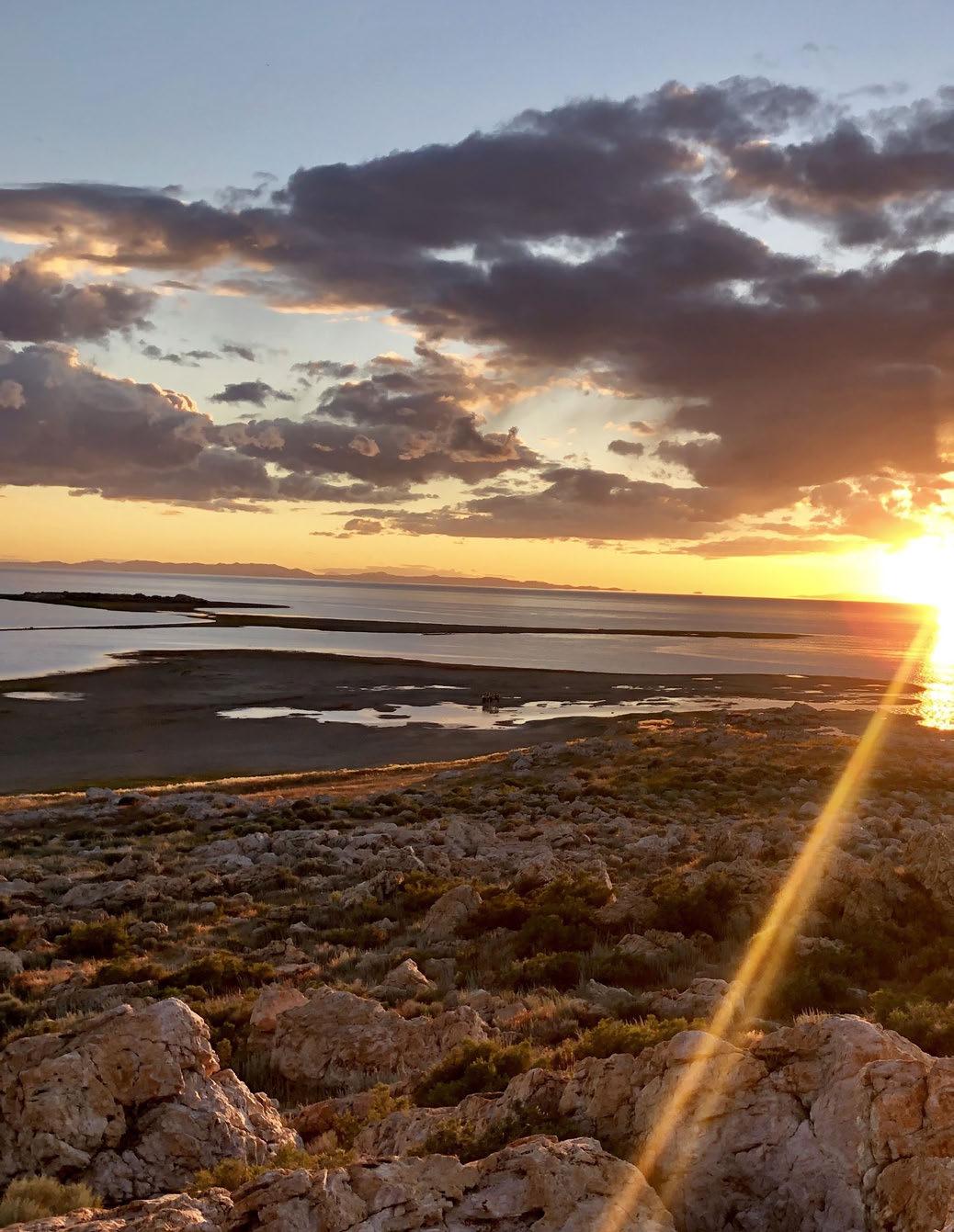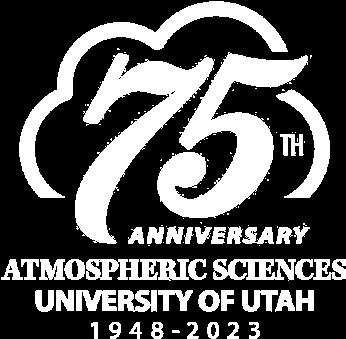
4


4
3.
4. Celebrating 75 Years
8. Faculty Profile: Jessica Haskins
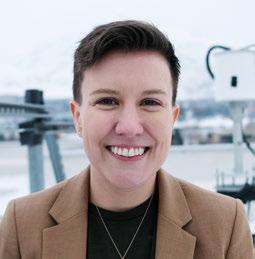
10. Alumni Profile: Steve Nesbitt
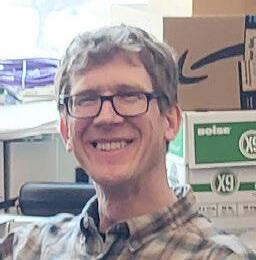
PUBLISHER DEPARTMENT OF ATMOSPHERIC SCIENCES UNIVERSITY OF UTAH


WILLIAM BROWNING BUILDING 135 S 1460 E, RM 819 SALT LAKE CITY, UT 84112-0102 801.581.6136
DEPARTMENT CHAIR
JOHN HOREL
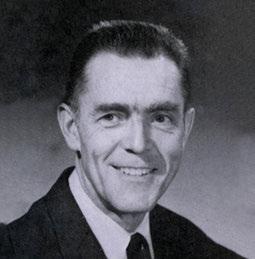
ASSOCIATE DIRECTOR OF MARKETING, COLLEGE OF SCIENCE
BIANCA LYON
ART DIRECTOR
TODD ANDERSON
LAYOUT & DESIGN
ADAM WHITE
WRITER & EDITOR
DAVID PACE
STAY CONNECTED
ON THE COVER:
Sunset
Visit, respond, subscribe, donate: www.atmos.utah.edu
WHEN I FIRST ARRIVED ON CAMPUS DURING SUMMER 1986, I WAS TASKED TO TRANSITION THE SYNOPTIC METEOROLOGY program to a more modern era—turn off the fax weather map machine, let’s use computers!

I discovered immediately that the vintage, wooden Applied Research Building housing the synoptic lab had an attic completely full of chemically-treated fax maps accumulated during the past decades just waiting for a spark to burn down the entire building (and maybe campus). It was definitely a time for change, and many more changes have continued in our Department since then. Now is a great opportunity for us to reflect on the accomplishments provided by all the people involved in the Department of Meteorology and Department of Atmospheric Sciences during the past seventy-five years.
More is to come! The merger of the College of Mines and Earth Sciences with the College of Science reflects increasing interdisciplinary opportunities. For example, we’ll be moving into a new building to be shared with Physics and Astronomy in 2025. The new Earth and Environmental Sciences major, Wilkes Center for Climate Science and Policy and Storm Peak Laboratory are more examples of new directions for our Department. Instructional methods, research opportunities, and ways to serve students and the public locally and worldwide continue to evolve and grow.
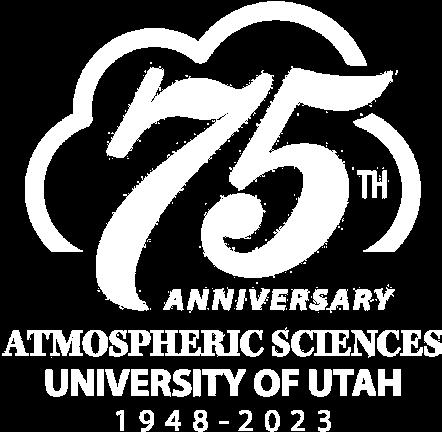
I hope you enjoy learning here about our past, current, and future activities.
Serving as Chair during the past five years has been a great, yet challenging experience, particularly during the COVID years. I’m really happy that our new Chair (to be announced
soon) will begin supplying new energy and direction for the Department. I have been around for nearly half of the Department’s seventy-five years and hope to hang out for a couple more. Although there is a lot of fun research and teaching left to do, I am a bit envious of many of you alums from my era who have retired before me!
JOHN HOREL Professor & Chair Department of Atmospheric Sciences
FOLLOWING WORLD WAR II, SCIENTIFICALLY BASED UNDERSTANDING OF THE ATMOSPHERE HAD SEVERAL DRIVERS. There was the need for government agencies to ensure protection of lives and property; the need to improve agriculture, water resources, aviation and surface transportation; and new opportunities provided by live TV weather forecasts to inform the public. In the ‘70s and ‘80s a second modernization wave led to improved weather models and surface and satellite observations that increased expectations for scientists to have advanced university undergraduate and graduate training. Atmospheric science is a field that continues to develop new technologies, bringing to bear what we know and can continue to learn about numerical methods, computer sciences, physics and chemistry, among other disciplines.
Today, the U’s Department of Atmospheric Sciences (ATMOS, formerly the Department of Meteorology) is the leading program of weather and climate-related research, education, and public service in the Intermountain West. With its 75th anniversary this year, we are reminded that this is a story about intrepid pioneers in the field and expansion to embrace studying environmental phenomena on spatial scales from the entire globe to tiny particles and on temporal scales from centuries to microseconds. It’s a story about the
men and women who built the buildings, developed the curricula, and conducted research, training, and service relevant to residents in Utah, the nation, and beyond.
Thank you for joining us in recalling, experiencing in the moment, and recommitting to the work of the Department of Atmospheric Sciences at the University of Utah.
After serving in the U.S. Army Air Corps in the Pacific Theatre during WWII, Vern Hales returned to Utah in 1946 to teach meteorology courses at the U in the physics department. In what must have been very limited spare time, while founding the department at the U, he completed his doctorate at UCLA in 1952 on atmospheric radiative transfer. “My interest became cloud seeding at the nearby airport,” he recalled. “I had many opportunities to experiment with different techniques of clearing the sky for airplanes.”
Hales was not the only one to emerge from the crucible of war to become an atmospheric scientist at the U. One of the department’s longest serving faculty members (1957-1986) was Donald R. Dickson who received his BS and MS degrees from ATMOS in 1950 and 1953, respectively. Dickson’s service in the Army Air Corps led to injuries in the line of duty
for which he received three Bronze Star medals and was recognized for his service in the European African Middle East Theatre.
Following Hales, Dickson took over the position of chair from 1963 to 1972, a time of exponential growth at the U. By 1950 student enrollment had more than doubled since the end of the War, then more than doubled again by 1970. A new campus was called for by President Ray Olpin who pushed an aggressive initiative through which ninety buildings would be planned, designed and constructed between 1945 and 1975.
In 1971, during Dickson’s tenure as chair, the U saw the construction and opening of the William Browning Mines and Mineral Industries Building, the new home of ATMOS and much of the College of Mines and Earth Sciences (CMES). Later, the nearby Intermountain Network Scientific Computer Center (INSCC) building also opened and currently accommodates ATMOS offices, classrooms, and a lecture hall.
Before and during the move to the Browning, the connection of ATMOS to UCLA continued when a research scientist at the Los Angeles campus, Shih-Kung Kao, was recruited in 1960. He was department chair from 1973 until his untimely death in 1981. Kao led research on many aspects of atmospheric dynamics, including the
transport of fallout from open-air atomic tests, of which the last one occurred in Nevada in 1962. While Kao was Chair, research funding increased substantively, and the graduate program expanded. In addition, the Air Force’s officer training and degree programs, already underway, led to the department’s largest undergraduate enrollments in its history.
As the program grew, Dr. Hales hired Aylmer H. Thompson. “A. H.” as he was known, who also worked during the late 1950s on a PhD at UCLA. Additional connections between ATMOS and UCLA might suggest a conspiracy of sorts, but the recruitment of Jan and Julia Nogués Paegle who had met at the California campus was all above board. In fact, one of the reasons the Pageles chose the U was because of the University’s accommodation to hire married researchers as couples. Julia recalls how the U was one of the nodes within the first nationwide computer network known as ARPANET that predated the Internet. Now
professors emeriti, the Paegles mentored dozens of doctoral and masters degree students. While their contributions are noteworthy across all aspects of research, teaching, and service, they energized the department in new directions with tropical and Southern Hemisphere research that brought many students and visitors from South America.
The arrival of faculty member Kuo-Nan Liou in 1975 accelerated the department’s growth. As an international leader in radiative transfer and cloud process research, he established the largest research group in the department’s history, involving staff, research faculty, postdoctoral researchers, and graduate students. He served as department chair immediately before reversing the flow of faculty exchange from UCLA to Utah by heading to UCLA himself in 1997. Deservedly, Liou received many awards from his peers for his work at the U and at UCLA, including from the American Meteorological
Society Charney and Rossby Awards, and recognition from the American Geophysical Union, National Academy of Engineering, and Chinese Academy of Sciences.
In 1977, two years following Liou’s arrival, the faculty was joined by Norihiko Fukuta, a world leader in cloud microphysics research with a state-of-the-art cloud chamber on the 8th floor of the Browning. Poor wintertime air quality episodes in northern Utah that are often accompanied by supercooled fog led Fukuta to innovative research in the late 1980s to seed fog layers at the Salt Lake City airport and elsewhere with liquid carbon dioxide droplets.
The College helped to expand the department by hiring prominent scientists as chairs in 1986 and 1999. John (Jack) Geisler was pried away from Florida to become ATMOS chair in 1982 and continued in the position until his retirement in 1996. His research and teaching centered on large-scale dynamics in the tropics and global modeling, and

his long tenure as chair provided the foundation for the department’s growth in research, teaching, and service pertaining to Utah and around the globe. Staff emerita Leslie Allaire remembers frequent trips Geisler made to Brazil with the Paegles to study the impacts of tropical sea surface temperature variations (El Niño/La Niña) on weather around the globe. There were also Geisler’s tales, she says, of spearing piranha in the Amazon.
Recruited from Texas A&M in1999, Edward Zipser served as chair until 2005. Zipser has the record for being an academic with the longest involvement (1960-2022) in aircraft field programs. His extensive contributions to the field have been recognized, including being the department’s second recipient of the




funding from NSF, DOE, NOAA, and NASA to improve numerical models and analyze satellite imagery leading to improved understanding of year-to-year variations and long-term trends in the climate system. Coincidentally, the advent of the Weather Channel with its around-the-clock updates of local and distant weather along with weather information at everyone’s fingertips via the Internet have helped raise the public’s and prospective students’ awareness of career opportunities in the field.
Atmospheric scientists, often found staring at a computer screen, live for the great outdoors. That they spend a good deal of their spare time craning their necks at

The first of many faculty brought to the U during Geisler’s fifteen-year tenure as chair was Dale Durran (subsequently followed by John Horel, Steven Krueger, James Steenburgh, and Gerald Mace). Dale’s research on terrain-flow interactions began at the U and continued at the University of Washington after his departure in 1997. Geisler’s era encompassed expanded opportunities relying on federal research
the sky and taking photos of clouds are indicators of their passion for knowing what’s going up and what’s coming down.
Currently, the department has research programs that run the gamut of winter weather from snapping photos of individual snowflakes to simulating precipitation in the Himalayas. Sensors onboard light rail cars and electric buses monitor asthmainducing air quality in the Salt Lake Valley while other equipment tracks dust plumes rising from the shrinking Great Salt Lake.
Studies are underway examining clouds over the Arctic and South Atlantic as well as hurricane genesis. Providing real-time data and graphics to government personnel fighting wildfires and improving models that simulate the smoke from those wildfires is increasingly important for the residents of the West, as is the measurement and evaluations of the chemical make-up of polluted air during the state’s notorious winter temperature inversions.
With the social media handle, @ProfessorPowder, James “Jim” Steenburgh is a Fulbright Scholar, author and blogger at the whimsically-named Wasatch Weather Weenies. The former department chair studies how storms interact with downstream topography to create optimal snow fall and the “Greatest Snow on Earth,” key to Utah’s winter sports economy.
West of the Wasatch, Kevin Perry travels across the lakebed of the Great Salt Lake using a specially designed fat tire bicycle pulling a trailer crammed with instruments. He and his colleagues, including research faculty Sebastian Hoch, are currently testing how much wind energy it takes to disturb the playa’s crust of the terminal lake and move the resulting dust which now contains toxins like arsenic into the urbanized Wasatch Front.
To assist the National Weather Service in its mission to protect lives and property, MesoWest team led by current chair John Horel has acquired and distributed over the Internet environmental data available publicly from tens of thousands of locations around the nation. Cloudbased software has expanded on the tools available from MesoWest to monitor weather conditions for protection of lives
and property from hazardous weather and for widespread commercial applications. The department’s reputation as a premier program in mountain meteorology has now been bolstered as operator of Storm Peak Laboratory located at the top of the Steamboat Springs Ski Area in Colorado. The facility is one of only a handful of high elevation weather research labs in the world and is under the direction of Gannet Hallar who joined the ATMOS faculty in 2016.
Our history is not simply about the academic faculty and its leadership. The department currently houses excellent research faculty, instructors, staff, postdoctoral researchers, and over a hundred undergraduate and graduate students. Visit atmos.utah.edu for a more complete listing of faculty, staff and students who have played and continue to play prominent roles in the Department of Atmospheric Sciences.

The next revolutions affecting weather forecasting will likely involve greater reliance on AI/machine learning tools and probabilistic numerical model guidance. Forecasting the exact high temperature tomorrow will continue to become less important than communicating accurately the risks and uncertainties of hazardous weather and climate variability and trends such as floods, droughts and heat waves.
The 2002 Salt Lake Winter Olympics accelerated mountain weather research in
the department. Installing weather sensors at venues, running high-resolution weather forecast models, ATMOS student venue volunteers and daily weather briefings with the local Olympic Committee were ATMOS’s high-profile activities as scientists, partnering with private and federal forecasters to embody the games’ motto to “Light the fire within.”
Whether the capital city will again host the Olympics in 2030 or ‘34 and involve weather support from ATMOS remains uncertain. What is certain is that the department is ready for its next seventyfive years. There’s the newly established Wilkes Center for Climate Science and Policy headed up by atmospheric scientist John Lin and forest ecologist William “Bill” Anderegg. The Center epitomizes the drive towards multidisciplinary science to address seemingly intractable issues surrounding climate change with the onus of providing data-driven deliverables to policy makers.
Finally, in 2025 ATMOS will relocate into the Crocker Science Complext on lower campus. The Department of Physics and Astronomy will also be tenants as will the Wilkes Center alongside teaching labs and classrooms wherein virtually every STEM student at the U will eventually intersect for a course, a practicum or a lecture. Embedded in the new building will be an expansion of the Science Research Initiative (SRI) wherein first-semester science students find themselves in a lab or in the field (or both) to learn by doing.
A catalyst for much of the multidisciplinary approach to fundamental and applied science is the merger of the College of Mines and Earth Sciences, where ATMOS is situated, with the College of Science. Seven departments and one school will now be more closely aligned administratively, pedagogically and in cross-pollinating research, teaching, and service. One of the first examples to have emerged from the new alignment is the establishment of a new major and minor of Earth & Environmental Science: a robust mix of atmospheric science, geology and ecology that will also intersect with virtually every department in the merged College.
The simple answer to this question is a lot has happened in the department and is continuing to happen today. From dark times following a world war, through new innovations of technology, theory and research, the future will be sunny. As we like to say here: The sky’s the limit.
The 75th anniversary of the department is made more meaningful by U alumni, faculty and students committing to the future of atmospheric science studies rooted in our past and present. There are many more stories to tell. Visit the ATMOS website to upload your memories and share any photos you may have at tinyurl.com/247uf8wn.

There may not be a lot in common with Salt Lake City and Forsyth, GA, population 4,239, but Monroe County’s seat–other than being home to the county’s only high school–does have a small community theater with the same name as one of Salt Lake City’s most notable venues: “The Rose.”
In Forsyth, the Rose Theater appears to stage family-friendly shows like “Four Weddings and An Elvis” (about a Las Vegas wedding chapel with a run which closed in
February). Later, this November 11th, there’s a single-night annual event “Hometown Gospel Sing.”
The theater located on Forsyth’s town square is emblematic of the small-town life in which Jessica Haskins grew up before winning a full-ride scholarship to the Massachusetts Institute of Technology (MIT). Her move from rural Georgia to the east coast megalopolis of Boston was shocking for reasons other than just the differences in weather and academic rigor.
“It was a punch in the face” says Haskins, “coming to MIT, and realizing that the experience of most Black Americans outside the southeast, particularly in STEM fields, is one where they often find themselves the only non-white person in the room.”
In fact, her time at Mary Persons High School was much more diverse than MIT. “None of the places I have worked at in
the last thirteen years since I graduated high school have come close to mirroring the racial and socioeconomic diversity I grew up thinking was the norm in all of America. As such, it’s never been difficult for me to see the power of privilege and the persistence of systemic racism at every stage of the STEM pipeline as I progressed through it,” she says of her hometown.
Now an assistant professor in the Department of Atmospheric Sciences at the University of Utah, Haskins is savvier about her own seemingly unlikely journey into higher education. More importantly, perhaps, she’s keenly aware of the challenges “first-gen” college students and other underrepresented populations still face, having to navigate hurdles referred to as the “hidden curriculum” of academia, things more privileged students tacitly understand or have been made aware of.
Fortunately, MIT treated Haskins well, brokering an “externship” with NASA’s Goddard Space Flight Center and providing an opportunity to work with Susan Solomon, a 2007 Nobel Peace Prize co-recipient best known for being the first to propose the chemical mechanism that is the cause of the Antarctic ozone hole. With Solomon, the budding atmospheric scientist did undergraduate research on a project that explains fundamental chemical and meteorological differences that prohibit the Arctic ozone hole from becoming as large as that in the Antarctic, resulting in a publication in PNAS.
Following her time at MIT, Haskins went on to complete a PhD at the University of Washington in Atmospheric Sciences and later returned to MIT for a short stint as an NSF Postdoctoral Fellow before being hired by the U. Needless to say, it wasn’t for the theater that she and her wife moved to Utah’s capital city. Rather it was the unique (and to her, compelling) challenges facing the state, particularly the winter PM2.5 and summer ozone air quality issues impacting the Wasatch Front, especially during periodic temperature “inversions” that trap emissions along the metropolitan valley.
An expert in the chemistry of how chloride present in salt impacts air quality, particularly in the winter, Haskins noted “there is no place in the U.S. that my research on air quality is more relevant to science and policy than it is in Salt Lake City.”
That’s because today, more episodes of unhealthy air quality in the U.S., including in Salt Lake City, are experienced in the winter rather than summer, pointing to a shift in the chemistry responsible for formation of secondary pollutants like particulate matter
(PM2.5), and ozone, the primary components of smog. Haskins’ past and future research focuses on understanding this type of shift through the lens of atmospheric chemistry with an eye towards understanding how future policy and climate solutions will impact air pollution formation.
Her research group at the U is particularly focused on understanding and accurately modeling heterogeneous and multiphase chemistry that transforms natural and anthropogenic (human-
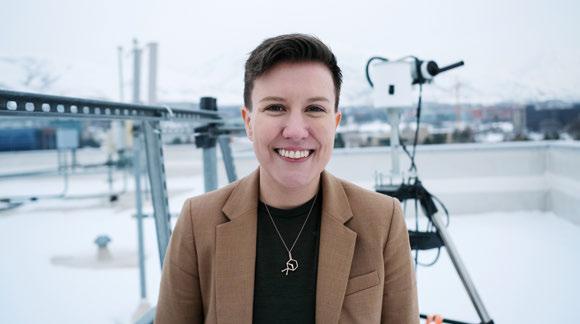
of these atmospheric oxidants–like OH, O3, NO3, and C1‘ radical–change in response to atmospheric water vapor, exposure to sunlight, temperature, aerosol surface area, emissions of gasses like NOx from combustion, etc. “These processes are challenging to measure, are highly variable and are therefore challenging to represent in models. Much remains to be discovered!”
derived) gas phase emissions into PM2.5. It turns out that, globally, exposure to PM2.5 is the fifth greatest risk factor for death. But in addition to the impact on human health, her research also has implications for understanding how aerosols will ultimately impact the Earth’s temperature and how climate change will impact future air quality which has global implications.
Haskins’ interdisciplinary research sits at the intersection of atmospheric science and chemistry and strives to deepen our understanding of the complex cascade of reactions between our emissions and atmospheric oxidants, which control how long gasses like methane stay in the atmosphere. It’s a gumbo of considerations that hinges, for Haskins, on her understanding of how concentrations
“One of the largest looming challenges our field faces now and, in the future,” Haskins has written, “will be connecting an ever-growing dataset of highly localized measurements to scientifically accurate, but computationally efficient representations in predictive global models.” All of those data sets along with new ones are key to improving global models of atmospheric composition, “serving to bridge this already significant but growing gap between the data we have and the data we use to inform predictive models and decision makers.”
Upcoming projects in her group include those re-analyzing old measurements to extract new constraints for models and involve new applications of machine learning and artificial intelligence (AI) to atmospheric chemistry problems. “The application of AI methods has only just begun to be applied to atmospheric chemistry problems,” she explains, “but could greatly improve the speed and accuracy of our models.”
It’s an exciting time to be an atmospheric scientist rooted in chemistry, and Jessica Haskins is looking forward to better understanding and communicating the relevant chemical drivers of variability in air pollution formation. But here in the high desert climate that has precious little in common with her Georgian home–except for that community theater thing– she is enthusiastic about building a diverse and collaborative research group in the Department of Atmospheric Sciences at the University of Utah.
THERE IS NO PLACE IN THE U.S. THAT MY RESEARCH ON AIR QUALITY IS MORE RELEVANT TO SCIENCE AND POLICY THAN IT IS IN SALT LAKE CITY.
THE DEPARTMENT OF ATMOSPHERIC SCIENCE’S FUTURE HOME IN THE CROCKER SCIENCE COMPLEX WILL INCLUDE offices and classrooms, shared with the Department of Physics & Astronomy. The facility will be located in the remodeled Stewart Building and a new 100,000-square-foot adjacent building.
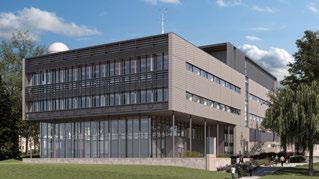
Excavation is already underway of the $93.5 million endeavor called the Applied Science Building, which will provide expanded facilities for teaching, research, and outreach. There, introductory classes will spread out in a 300-seat auditorium shared with Physics & Astronomy. Multiple screens and seating designed for desktop and laptop computers in one of the classrooms will help students visualize complex topics in upper division and graduate classes. Instrumentation and a classroom on the roof have been designed for hands-on instruction—students will be able to watch and monitor the weather as it happens.
Research groups will occupy seven labs and include the greenhouse gas calibration facility and cloud physics, air chemistry and instrumentation labs. Faculty and students involved in the Utah Weather Center will use the video wall located in the Wilkes Center for Climate Science and Policy to describe past, current, and future weather and climate events.
K-12 groups along with the general public will be able to peer into the cold room chamber in Professor Tim Garrett’s cloud physics lab and participate in handson demos in the rooftop classroom. And, when the weather cooperates, people will head outdoors to chat and relax on the extensive patio, the centerpiece of the Crocker Science Complex.
Want to help equip the new facilities for our future students? Contact TJ McMullin at travis.mcmullin@utah.edu for more details.
It’s a cruel joke directed at the upstate New York NFL team that despite making four straight Super Bowl appearances (1990-1993) has yet to hoist the Lombardi Trophy. But it’s not likely one to bother Buffalo native Steve Nesbitt. He can still be seen wearing his Bills jersey, hat and other garb as the faithful fan whose hope springs eternal with no apologies.

Recipient of the 2022-23 Distinguished Alumni from ATMOS, Nesbitt leads a research group that makes stunning observations of the troposphere. These include the remote sensing of precipitation using radar and passive microwave sensors as well modeling of cloud dynamics and microphysics, land-atmosphere interaction, as well as data science and high-performance computation.
“Some of the most fundamental and complex research problems in climate and weather,” writes Nesbitt, centers on “our poor understanding of basic
properties of clouds and precipitation and our inability to determine quantitatively the many effects cloud and precipitation processes have on weather and climate.”
The uncertainty is complicated by global warming. “In the future,” he says, “my goal is to continue to contribute important advances in this area as the complex challenges that involve flows of water and energy through the earth system.”
A native of the snow belt, Nesbitt first took an interest in the weather as a nineyear-old when he would slide off the roof of his parents’ house into massive snow drifts. Transfixed by the Weather Channel he called the local NWS bureau on his own and asked for a tour. They complied. Many years later, mentored by Ed Zipser at Texas A&M, Nesbitt followed him to Utah when the celebrated observational meteorologist accepted a position at the U. Nesbitt earned his own PhD in 2003.
Q: WHAT DOES A BUFFALO BILLS FAN DO WHEN HIS TEAM HAS WON THE SUPER BOWL?
A: HE TURNS OFF THE PLAYSTATION 3.
“You get goosebumps,” Nesbitt says about his current work at the University of Illinois Urbana-Champaign where he is the associate head and director of graduate studies. “When you go out and plan an experiment about the things that already excite you and collect data with these amazing instruments to quantify how these things work, I sometimes pinch myself: how do I get paid to do this?”
This kind of research has come a long way since the ‘90s. Nesbitt recalls the five-tosix hours it took to read one summary report off of magnetic tapes from NASA’s first satellite-derived data. “We had no idea what we’d see,” he says. No longer were they only seeing pictures but vertical x-rays inside of clouds. Of course, twenty of those tapes he and his team painstakingly read back in the day could now be stored on an I-Phone. Even so, “it was a real breakthrough,” Nesbitt says of satellite technology.

NASA also funded major field campaigns to validate what data researchers were studying from satellites. A U2 spy plane was converted into research aircraft and piloted at seventy thousand feet to probe through storms, collecting visual and hands-on experiences as corroboration. Technology has not only assisted Nesbitt in collecting
data, but analyzing it through sophisticated artificial intelligence models to predict impacts from large data sets with large uncertainties.
In Cordoba, Argentina the uncertainties of storms have real-life consequences–just as they do in Buffalo, where last December, lake-effect snow and wind combined in an unusually catastrophic combination. Nesbitt and collaborators were funded $20 million to stage the largest land-based field campaign effort ever conducted outside of the U.S. in the atmospheric sciences. They set up observation sites and dispatched radar trucks (that decades ago inspired the movie “Twister”) on the eastern foothills of the Andes where thunderstorms develop rapidly, some of them twenty-one kilometers tall with an updraft chimney fifty kilometers wide. The confluence of data from multiple dimensions allows for greater predictability of future weather events even with the chaotic nature of convective storms. The impact of global warming on precipitation processes remains a critical research area, and Nesbitt’s work is at the center of that.
Nesbitt’s time in Utah was complemented by the 2002 Winter Olympics. “It was a really exciting time,” he
says, remembering the weather observing ATMOS did for the games as well as the invitation to see the dress rehearsal of the opening ceremonies. And then there was the lake-effect snow stemming from the Great Salt Lake though not quite as extreme as Buffalo’s. He learned to ski and found faculty members’ passion for Utah’s winter sports and the “interesting weather” along the Wasatch Front infectious. He also married a local.
Of late, Nesbitt has trained his sights on the representation of ice clouds, which produce the majority of earth’s precipitation, yet are the most difficult to simulate and observe due to their complex microphysical nature.
Steve Nesbitt’s arrival in Salt Lake earlier this year to accept his award was a homecoming in multiple ways. He got to experience again the campus and its setting which first “sold” him on attending the U. It validated the work he’s been engrossed in ever since he slid off the roof into those Buffalo snow drifts. It was also a reunion of many fellow atmospheric scientists, including department chair John Horel: “Most importantly,” Horel says, “Steve is a dedicated dad, BBQ grill master, and avid Buffalo Bills fan.” No PlayStation 3 needed.
Over forty years ago what would become the premier, high-elevation atmospheric science laboratory in the Western United States opened at Steamboat Springs Ski Resort in Colorado. Storm Peak, as the facility is called, has been “the perfect place, to have your head in the clouds,” says director Gannet Hallar, professor of atmospheric sciences at the U. The laboratory sits in the clouds about 40 percent of the time in the winter. “That allows us to sample clouds and the particles that make clouds at the same time. And from that, the lab has produced about 150 peer-reviewed publications.”
Named after the peak which stands at 10,500 feet above sea level, the 3,500-square-foot lab is not only the perfect place for established researchers but for budding scientists who are studying what
changes a cloud, what makes it snow versus what makes it not snow and what makes more versus less ice in the atmosphere, among other questions.
This year twelve students in the new Science Research Initiative at the College of Science atmospheric science research will make the five-hour road trip to Steamboat Springs, then take the chairlift to Storm Peak. Funded by the National Science Foundation and operated under a permit from the U.S. Forest Service, the storied lab has an incredible record of long-term atmospheric measurements, “critical,” according to Hallar, to the success of the site and for the broader understanding we need to improve climate predictions.

Hallar has the advantage of operating out of two locations: Storm Peak where regional air quality through long data records is determined over decades of change, as well as the top floor and roof of the Browning Building at the U’s main Salt Lake campus where she studies urban
air quality. One week students and faculty collaborators can be seen using a multifilter showdowband radiometer overlooking the Salt Lake Valley and then the next week literally in the clouds witnessing science in the making. Students “can learn concepts in the classroom and then watch that data appear physically in front of their eyes,” says Hallar. “They can see the concept of photochemistry as it appears, how … the concentration of gases change as the sun comes up.”
As pristine as the air is at Storm Peak, just west of the Continental Divide in the northwest corner of the state, it is also typical of rural areas in the U.S. where coal plant emissions can impact atmospheric composition. Two of those plants are upwind of the facility which makes the measurements Hallar and her team collect even more relevant to other rural locations.
“What’s amazing about this place is that we have shown over the fifteen plus years that we’ve run undergraduate programs that it’s a place of inspiration.” Students learn how important changes in gases are in terms of public health and climate. “I think it’s important for our students to come and see us measuring and calibrating carefully. They can see the care and precision taken to measure greenhouse gases.”
Not all greenhouse gases are humanderived. Wildfires in the West have become a new variable in measuring atmospheric composition, involving forest ecologists like William Anderegg, director of the Wilkes Center for Climate Science and Policy at the U. And there are other measurements being done at Storm Peak that might prove surprising. “We’ve done studies on how tree emissions change when beetle infestation happens,” says Hallar, which impacts air quality as well.
Storm Peak is just one node in the Global Atmospheric Watch Network, a consortium of labs and observation sites that together address atmospheric composition on all scales, from global and regional to local and urban. Hallar and her team work closely with sites on Mt. Washington and Whiteface, in New Hampshire and New York, respectively, as well Mt. Bachelor in Oregon, among others. Recently, the team submitted a proposal to collaborate with Pico del Este, a field site in Puerto Rico.
It will require collaboration on a global scale to address climate change, and aerosol particle research, says Hallar, “is most definitely the critical measurement that [atmospheric scientists] need to make.” In addition to measuring methane–a critical player because of its warming potential–at Storm Peak, “we can see what we call the Keeling Curve. We can see how carbon dioxide increases every year, but has a seasonal cycle, that is associated with how trees and plants uptake carbon dioxide.

Meanwhile, students are preparing for their field trip to Storm Peak in March where the ski resort will not only provide transportation up to the facility via lift but ski passes. A staging facility down in west Steamboat Springs houses equipment that includes a snow cat, snowmobiles and other equipment. Up top, bunks are limited to nine, so there is a lot of travel up and down the slopes. But it’s worth it for students to get their collective head in the clouds to work with instrumentation critical to measuring clean air and discovering ramifications more broadly in terms of global warming.
And then there’s always the view. Spectacular.
WAITING FOR THE SIGNAL TO TAKE OFF WAS ADRENALINE-INDUCING; THE ANTICIPATION OF THE FLIGHT ahead was exciting all by itself. But nothing compares to when the pilot puts the jet into full throttle and you’re slammed to the back of your seat as the pilot shoots the jet out of the gate. It’s something I’ll never forget.
This flight was the culmination of my experiential learning component for the ATMOS major, for which I decided to do a career-focused internship at Naval Air Station Lemoore in California. It took a week of intensive training to prepare my fellow Midshipmen and me to ride “rear-seat” in an F/A-18F Super Hornet, from getting familiar with an ejection seat which has seven individual straps to keep you firmly secured to the seat to learning the Anti-G Straining Maneuver to combat what’s called “G-Force Induced Loss of Consciousness.” How do you untangle a parachute and inflate a life vest in the
event of an ejection over water? We covered that as well.
During training with the Naval Search and Rescue (SAR), I played a “victim” and was hoisted out of a hardto-reach ravine by helicopter. To speed up the evacuation, the helicopter began to travel forward before I was fully secured in the cabin. This meant I was flying through a valley, dangling from a helicopter at high speed.
The life of a fighter pilot or flight officer is very enticing, but I am still comfortable with my decision to be a Meteorologist and Oceanographer (METOC). My time at Lemoore has helped me grow more confident in my decision to join the U.S. Navy and the career path I have in front of me.
Luke Reuschel is commissioning as a navy officer this spring. You can help fund thrilling and educational experiences like his by making a donation to ATMOS undergraduate education.
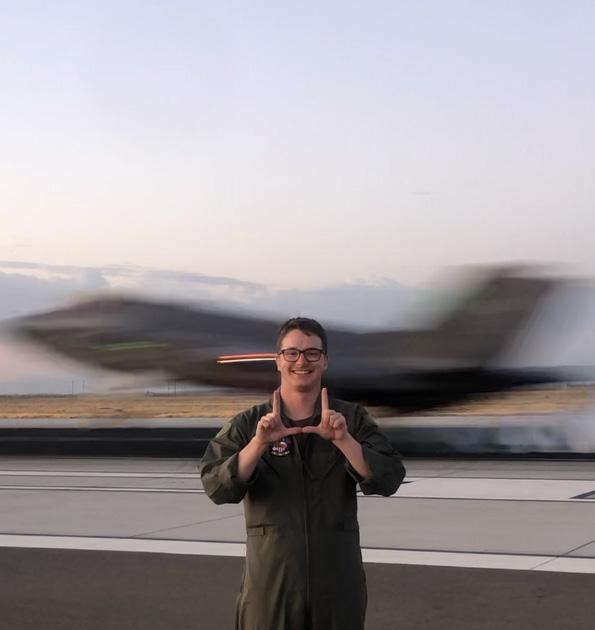
ON ANY GIVEN DAY YOU CAN FIND ATMOS’s SEBASTIAN HOCH IN HIS OFFICE CLOISTERED AMONG MULTIPLE computer screens, prototypes of field instrumentation, books, papers and mementos from his robust field campaigns over the past twenty years from Greenland to the Arizona Meteor Crater, and from Switzerland to Sable Island, situated 300 km (190 mi) southeast of Halifax, Nova Scotia. From his office he can watch, in realtime, data populating on his screens.
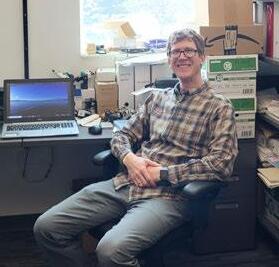
Until he can’t. Currently, the source of his data comes from a dust tower he’s installed on the playa of the Great Salt Lake, a harsh environment where equipment is difficult to maintain. On a visit in early February he discovered the reason why the voltage of his batteries has been dropping. After the lakebed temporarily flooded, a sheet of ice had formed and had been dislodged by the
capricious winds that form over the basin of this now rapidly shrinking terminal lake. The ice shattered against his solar panels and buried them under several inches of ice.
Located in the former Farmington Bay, the tower can only be accessed across the lakebed using a fat tire bicycle, towing a trailer filled with tools. Under the direction of principal investigator Kevin Perry, Hoch is taking research at the lake to a new level. While earlier research has determined the toxins–among them arsenic–that are in the drying lakebed, now the team is taking readings of how and when dangerous dust is “lofted” into the atmosphere.

“The variable I need to come up with,” says Hoch, “is threshold friction velocity that modelers can then use … to say, ‘okay, we’re going to have this type of wind, these types of flow, so under the current state of the lakebed surface, there’s going to be a
dust storm.’” Understanding the direction and speed of the wind along with what we know about how past weather defines the condition of the crust of the soil will improve predictions leading to possible interventions to protect populations along the Wasatch Front.

THE APPLIED SCIENCE BUILDING WILL HOUSE THE DEPARTMENT OF ATMOSPHERIC SCIENCES, DEPARTMENT of Physics & Astronomy, and the Wilkes Center for Climate Science & Policy. In FY22 the two departments taught over 5,700 students and brought in nearly $13.1 million in external research funding. Both
the University and the State Legislature consider this project a high priority as it supports Utah’s STEM economy and addresses serious educational and safety needs on campus. Undergraduate scholarships also remain a critical area of need as we seek to grow enrollment, alleviate the financial burden on our
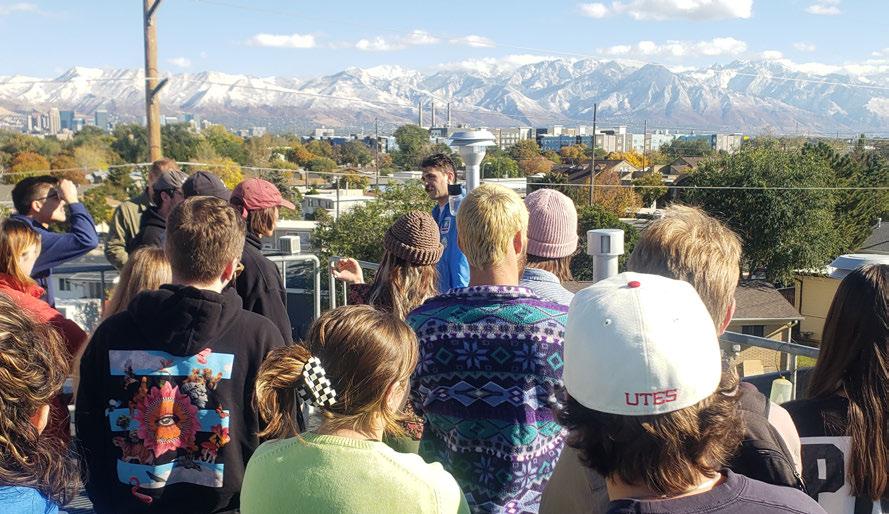
students, and prepare the next generation of atmospheric scientists. Donor-funded scholarships allow ATMOS to provide life-changing educational and research experiences at an exceptional value. For a limited time, the U is offering matching incentives for new multi-year scholarship pledges and/or new endowed scholarships.
WE INVITE YOU TO GIVE TO ATMOS Contact TJ McMullin for more info at travis.mcmullin@utah.edu
ATMOS Scholarships: giving.utah.edu/atmosscholarships
Applied Science Project: giving.utah.edu/appliedsciences
